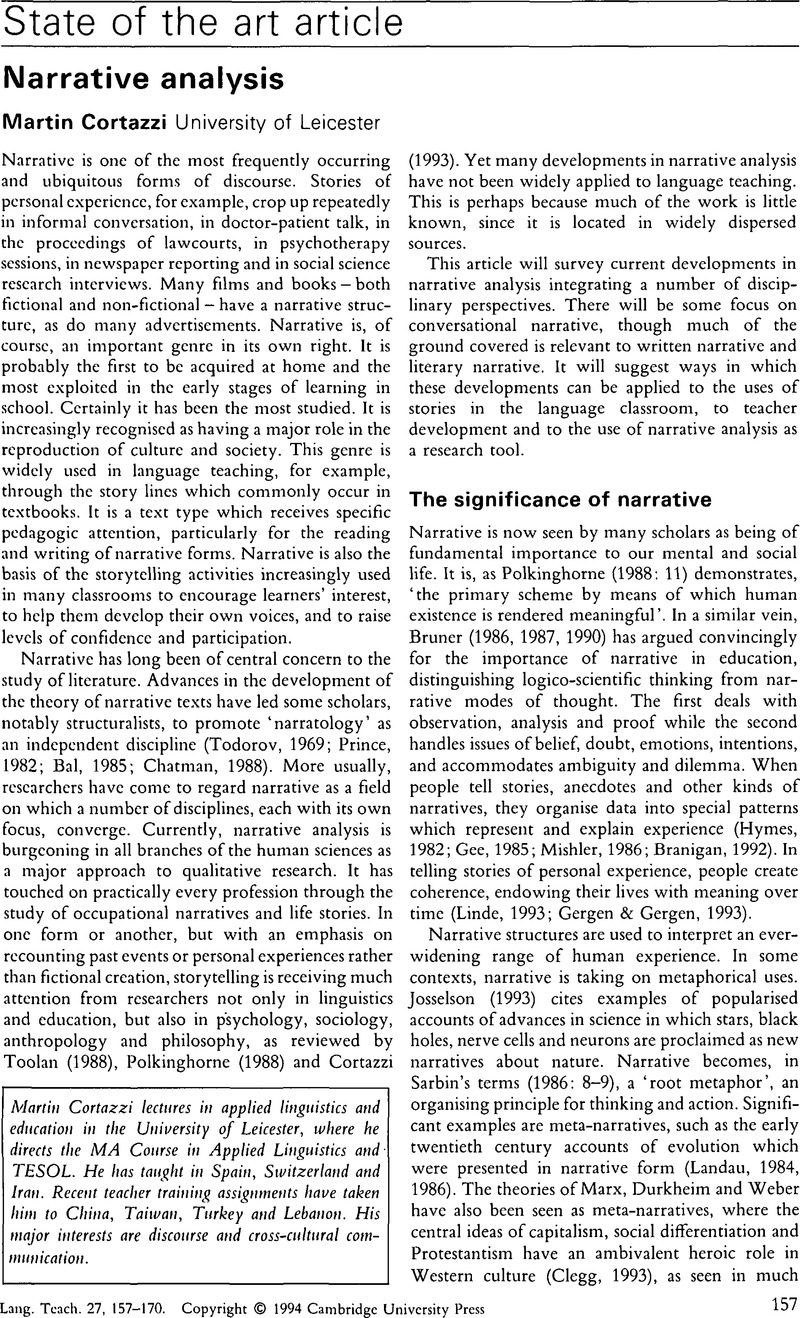Crossref Citations
This article has been cited by the following publications. This list is generated based on data provided by Crossref.
Bartels, Nat
2005.
Applied Linguistics and Language Teacher Education.
Vol. 4,
Issue. ,
p.
1.
Gu, Peter Yongqi
Hu, Guangwei
and
Zhang, Lawrence Jun
2005.
Investigating Language Learner Strategies among Lower Primary School Pupils in Singapore.
Language and Education,
Vol. 19,
Issue. 4,
p.
281.
Whiteley, Alma
Price, Christine
and
Palmer, Rod
2013.
Corporate culture change: adaptive culture structuration and negotiated practice.
Journal of Workplace Learning,
Vol. 25,
Issue. 7,
p.
476.
Kozakowski, Stanley M.
Eiff, M. Patrice
Green, Larry A.
Pugno, Perry A.
Waller, Elaine
Jones, Samuel M.
Fetter, Gerald
and
Carney, Patricia A.
2015.
Five Key Leadership Actions Needed to Redesign Family Medicine Residencies.
Journal of Graduate Medical Education,
Vol. 7,
Issue. 2,
p.
187.
Kennedy, Eileen
and
Gray, Morag
2016.
‘You’re facing that machine but there’s a human being behind it’: students’ affective experiences on an online doctoral programme.
Pedagogy, Culture & Society,
Vol. 24,
Issue. 3,
p.
417.
Nasheeda, Aishath
Abdullah, Haslinda Binti
Krauss, Steven Eric
and
Ahmed, Nobaya Binti
2019.
Transforming Transcripts Into Stories: A Multimethod Approach to Narrative Analysis.
International Journal of Qualitative Methods,
Vol. 18,
Issue. ,
Huang, Tianle
and
Grant, Will J.
2020.
A Good Story Well Told: Storytelling Components That Impact Science Video Popularity on YouTube.
Frontiers in Communication,
Vol. 5,
Issue. ,
YAZICI, Nermin
ALTUNTAŞ GÜRSOY, İlke
and
DEMİREL AYDEMİR, Gül Deniz
2021.
Aspects of Narrative Competence in Language Levels and Narrative Texts in the CEFR1.
Kastamonu Eğitim Dergisi,
Vol. 29,
Issue. 3,
p.
559.
Azzahrawi, Rawia
2021.
Engaging in narrative inquiry ethically and honorably.
SN Social Sciences,
Vol. 1,
Issue. 4,
Brömmelstroet, Marco te
Mladenović, Miloš N.
Nikolaeva, Anna
Gaziulusoy, İdil
Ferreira, Antonio
Schmidt-Thomé, Kaisa
Ritvos, Roope
Sousa, Silvia
and
Bergsma, Bernadette
2022.
Identifying, nurturing and empowering alternative mobility narratives.
Journal of Urban Mobility,
Vol. 2,
Issue. ,
p.
100031.
Pluquailec, Jill
2022.
Dis/orientating Autism, Childhood, and Dis/ability.
p.
73.
Wong, Yongkang
Fan, Shaojing
Guo, Yangyang
Xu, Ziwei
Stephen, Karen
Sheoran, Rishabh
Bhamidipati, Anusha
Barsopia, Vivek
Liu, Jianquan
and
Kankanhalli, Mohan
2022.
Compute to Tell the Tale: Goal-Driven Narrative Generation.
p.
6875.
Little, Ross
and
Warr, Jason
2022.
Abstraction, belonging and comfort in the prison classroom.
Incarceration,
Vol. 3,
Issue. 3,
Volioti, Christina
Orovas, Christos
Sapounidis, Theodosios
Trachanas, George
and
Keramopoulos, Euclid
2023.
Augmented Reality in Primary Education: An Active Learning Approach in Mathematics.
Computers,
Vol. 12,
Issue. 10,
p.
207.
KUTLU, Mahmut
2023.
An Evaluation on the Cinematographic Presentation of Historical and Spiritual Characters.
Medya ve Din Araştırmaları Dergisi,
Vol. 6,
Issue. 2,
p.
186.
van der Westhuizen, Thea
and
Adelakun, Yemisi
2023.
Social entrepreneurship in Nigeria through drivers of religion and work-desire.
Journal of Entrepreneurship in Emerging Economies,
Vol. 15,
Issue. 4,
p.
727.
Simons, Greg
and
Glaser (Kukartseva), Marina A.
2024.
New Zealand’s Foreign Policy Balancing of China and the United States in the Indo-Pacific Region: Narratives from the Ministry of Foreign Affairs Annual Reports.
Vestnik RUDN. International Relations,
Vol. 24,
Issue. 4,
p.
545.
Morris-Howe, Lay-nah Blue
and
DeDiego, Amanda C.
2024.
“Mixed:” Exploring Narratives of Single Mothers and Adult Children in Multiple Heritage Families.
Contemporary Family Therapy,
Vol. 46,
Issue. 4,
p.
373.
Little, Ross
2025.
Moral sight and ethical praxis in the prison classroom.
Criminology & Criminal Justice,
Vol. 25,
Issue. 4,
p.
1117.
Fay, Richard
and
Kostoulas, Achilleas
2025.
Doctoral Study and Getting Published.
p.
1.


